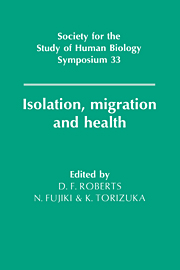Book contents
- Frontmatter
- Contents
- List of contributors
- Preface
- 1 The legacy of the IBP: Presidential Address
- 2 The distinction between primary and secondary isolates
- 3 Time trends in the break-up of isolates
- 4 Factors influencing the frequency of consanguineous marriages in Japan
- 5 Break-up of isolates
- 6 Isolates in India: their origin and characterisation
- 7 Consanguineous marriages and their genetical consequences in some Indian populations
- 8 Biomedical and immunogenetic variation in isolated populations in India
- 9 Genetic distance analyses in Israeli groups using classical markers and DNA polymorphisms in the β globin gene
- 10 Non-random distribution of Gm haplotypes in northern Siberia
- 11 Allele frequency estimation
- 12 Genetic affinities of human populations
- 13 Inherited neurological diseases in island isolates in southern Japan
- 14 Serological and virological evidence for human T-lymphotropic virus type I infection among the isolated Hagahai of Papua New Guinea
- 15 Analysis of genes associated with hypercholesterolaemia in the Japanese population
- 16 Migrant studies and their problems
- 17 Tokelau: migration and health in a small Polynesian society - a longitudinal study
- 18 Micromigrations of isolated Tuareg tribes of the Sahara Desert
- 19 Population structure in the eastern Adriatic: the influence of historical processes, migration patterns, isolation and ecological pressures, and their interaction
- 20 Diabetes and diabetic macroangiopathy in Japanese-Americans
- 21 Diabetes and westernisation in Japanese migrants
- 22 Environmental factors affecting ischemic heart disease
- Epilogue
- Index
20 - Diabetes and diabetic macroangiopathy in Japanese-Americans
Published online by Cambridge University Press: 05 March 2012
- Frontmatter
- Contents
- List of contributors
- Preface
- 1 The legacy of the IBP: Presidential Address
- 2 The distinction between primary and secondary isolates
- 3 Time trends in the break-up of isolates
- 4 Factors influencing the frequency of consanguineous marriages in Japan
- 5 Break-up of isolates
- 6 Isolates in India: their origin and characterisation
- 7 Consanguineous marriages and their genetical consequences in some Indian populations
- 8 Biomedical and immunogenetic variation in isolated populations in India
- 9 Genetic distance analyses in Israeli groups using classical markers and DNA polymorphisms in the β globin gene
- 10 Non-random distribution of Gm haplotypes in northern Siberia
- 11 Allele frequency estimation
- 12 Genetic affinities of human populations
- 13 Inherited neurological diseases in island isolates in southern Japan
- 14 Serological and virological evidence for human T-lymphotropic virus type I infection among the isolated Hagahai of Papua New Guinea
- 15 Analysis of genes associated with hypercholesterolaemia in the Japanese population
- 16 Migrant studies and their problems
- 17 Tokelau: migration and health in a small Polynesian society - a longitudinal study
- 18 Micromigrations of isolated Tuareg tribes of the Sahara Desert
- 19 Population structure in the eastern Adriatic: the influence of historical processes, migration patterns, isolation and ecological pressures, and their interaction
- 20 Diabetes and diabetic macroangiopathy in Japanese-Americans
- 21 Diabetes and westernisation in Japanese migrants
- 22 Environmental factors affecting ischemic heart disease
- Epilogue
- Index
Summary
It is generally thought that in Japanese the incidence of cerebrovascular diseases was formerly high and the incidence of ischemic heart diseases and diabetes low (Kays et al., 1966; WHO, 1980), but that recent westernisation of the Japanese life style, particularly diet, has brought changes. To clarify the influences of westernisation of life style on diseases in Japanese, in a recent survey Japanese-Americans, in whom westernisation of life style occurred earlier and more intensively, were compared with Japanese living in Japan, where these changes have been later and less pronounced.
The survey of Japanese-Americans was started in 1970 in Hilo City and Kona District, Hawaii. In 1978, the survey in Los Angeles was started. The results of the first of these surveys of Japanese-Americans, and of Japanese in Hiroshima Prefecture, have already been reported (Kawate et al., 1979). This paper reports the results of subsequent surveys in Hawaii, Los Angeles and Hiroshima, placing emphasis on the characteristics of diabetes mellitus among Japanese-Americans.
Background of Japanese migrants and their offspring
Emigration of Japanese to Hawaii began around 1885 in reply to the request from the Hawaiian Dynasty of those days to alleviate the shortage of labour for the sugar cane plantations. After World War II, the social status of these migrants improved sharply. At present, second- and third-generation Japanese-Americans are active in various occupations in Hawaii. In Hilo City on the island of Hawaii where the survey was conducted, 14,000 Japanese-Americans live, exceeding the population of white Americans in that city. The Japanese migrants living in Hilo City came from various prefectures of Japan, and have organised societies of people from each prefecture.
- Type
- Chapter
- Information
- Isolation, Migration and Health , pp. 219 - 232Publisher: Cambridge University PressPrint publication year: 1992



